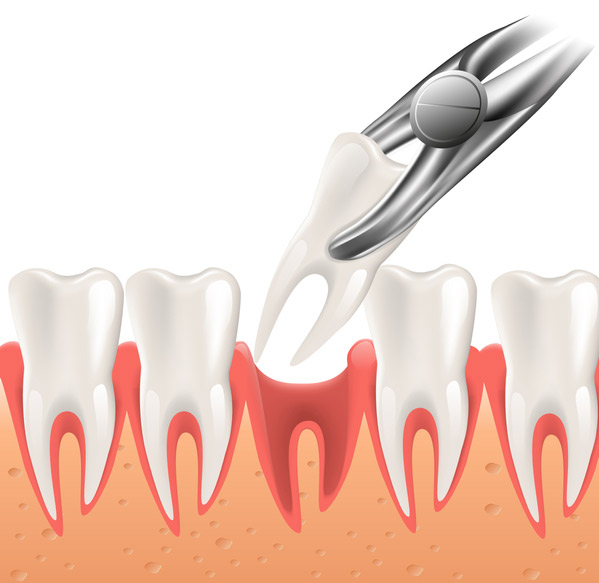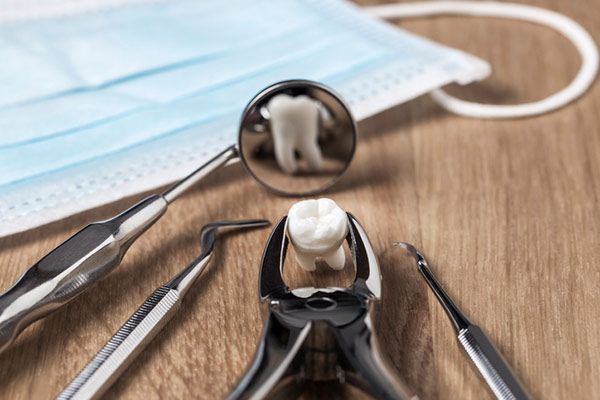 The extraction of the tooth is the full removal of the tooth.
The extraction of the tooth is the full removal of the tooth. Extraction is never our primary objective, we first look to see if saving the natural tooth structure is possible. Repairs can often be made with a dental crown. When repair is not possible, or when it’s placement can be harmful to your oral health, we then discuss extraction.
At Placentia Oral Surgery we understand that there are times when it makes more sense to extract. We are happy to discuss treatment following an examination, which may include extraction.
In general we extract teeth when they are:
| • | Impacted: An Impacted tooth is a tooth that is unable to come up fully into position from the gumline. This is often the case for wisdom teeth, though also occurs regularly with cuspids, or canine teeth, and can occur with any tooth. If the tooth can not be uncovered, it is best to be extracted. |
| • | Severely Decayed: A tooth that has lost significant structure due to decay may require extraction. There has to be enough structure to attach a crown to restore. |
| • | Broken Below the Gumline: A tooth that has cracked or broken below the gumline may have lost enough structure integrity that extraction is necessary. |
| • | Extra or Unnecessary: Sometimes a patient has extra teeth, wisdom teeth, or unnecessary teeth, that try to grow in the same location as other teeth. They can push teeth out of alignment and cause other issues. Extraction may be best. |
| • | Part of Orthodontics Treatment Plan: An orthodontist may request a tooth to be extracted as part of your orthodontic treatment plan. Following its removal, the plan would include the controlled movement of neighboring teeth. |
| • | Tissue Loss Due To Chronic Periodontitis: Though it may sound unusual, when a patient suffers chronic periodontitis significant enough that gum tissue and bone tissue has has been lost, the best course of repairing the tissue loss could be the removal of unhealthy teeth. We may create a treatment restoration plan that includes the placement of dental implants and/or a prosthodontic following extraction. |
Extraction Procedure
Tooth extraction is generally categorized as either simple or surgical. Sometimes a simple extraction can quickly turn into a surgical extraction.
Simple Extraction
A simple extraction means that we were able to remove the entire tooth and the root system whole.
We can simply remove the whole thing in one piece using an elevator tool to lift the tooth from the root and forceps to pull it out.
Surgical Extraction
A surgical extraction is necessary if the tooth structure has been compromised, weakened, or if the tooth is impacted. In a surgical extraction we section, or quarter, the tooth. This means that we intentionally cut the tooth into pieces. We will then remove all of the pieces. Cuts may also need to be made to the gum tissue to retrieve all pieces and then sutures may need to be placed.

Post Extraction
Following your extraction, we will discuss care treatment with you.
We ask that you do not drive yourself following an extraction, plan to have someone with you to drive. Additionally, assume that you will not be returning to work that day, and maybe an extra day or two. We will want you to relax to help the wound heal and prevent additional bleeding.
Extraction Aftercare
In the first few hours post extraction, you may experience some bleeding. Use the gauze provided to pack the wound to slow any bleeding. Much of the blood you see will be mixed with saliva making it appear to be more than it is. If bleeding seems excessive or unusual, please contact our office and seek medical help.
You will most likely have some swelling, and you can cut down on that by using an ice pack. We may prescribe some pain relief medication, or we can discuss over the counter pain relievers. Make sure that you take pain relief medication as directed. We may also prescribe an antibiotic. If that is the case, you will need to take the full course, even when you are feeling better. You will also want to stick to soft foods while you heal.
About 24 hours after the extraction you will want to start gargling salt water. This will reduce bacteria in your mouth and promote healing. You will make your salt rinse yourself by dissolving a half teaspoon of salt in a cup of warm water. Rinse the area, spit, do not swallow.
Replacing a Tooth After Extraction
After the tooth extraction, we will discuss what the next step should be. There are ways to replace a tooth, such as the placement of dental implants. Some teeth we will not want to replace. Wisdom teeth are a good example of that.
Tooth Extraction in Placentia CA
At Placentia Oral Surgery, we understand that sometimes an extracted tooth can lead to better oral health.
Contact us today or call (657) 216-1617 to schedule an appointment!
Frequently Asked Questions
Should I Get My Extracted Tooth Replaced?
It's often advisable to replace an extracted tooth to maintain oral function and prevent issues like shifting of adjacent teeth, bite problems, and bone loss. Options for replacement include dental implants, bridges, or partial dentures. Your dentist can recommend the best solution based on your specific needs.
How To Care For An Extraction Site?
After a tooth extraction, it's important to follow your dentist's care instructions to promote healing. This includes avoiding vigorous rinsing, sucking, or smoking for the first few days, eating soft foods, and gently rinsing with salt water. It's also crucial to continue brushing and flossing your other teeth, being careful around the extraction site.

